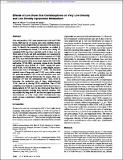| dc.description.abstract | Oral contraceptives (OC) raise plasma triglyceride and VLDL levels, which may be of concern, since some conditions characterized by elevated triglycerides are associated with atherosclerosis. To identify the responsible mechanism, we studied 11 healthy premenopausal women, 5 of whom were taking OC containing 0.035 mg ethinyl estradiol, and 6 of whom were not. Their rates of VLDL and LDL metabolism were measured by endogenously labeling apoB, the protein component of VLDL and LDL, by an intravenous infusion of deuterated leucine. OC use had the greatest effect on the large, triglyceride-rich VLDL subfraction (Sf 60-400), increasing plasma levels threefold and production rates fivefold (P < 0.05). Among OC users, small VLDL (Sf 20-60) levels were 2.2 times higher, and production rates were 3.4-fold higher (P < 0.05). The fractional catabolic rates of large and small VLDL were similar among OC users and nonusers. LDL levels and metabolic rates were not significantly different between the two groups. Thus, contemporary low dose OC substantially raise VLDL levels by increasing the production rate of large, triglyceride-rich VLDL, and not by slowing VLDL catabolism. Since VLDL catabolism is not impaired, we speculate that the hypertriglyceridemia induced by OC may be less atherogenic than that of hypertriglyceridemia resulting from impaired lipolysis. This may explain why long-term OC use does not appear to promote atherosclerosis. PIP: At Brigham and Women's Hospital in Boston, Massachusetts, data on 5 women aged 22-24 years using low-dose oral contraceptives (OCs) containing .035 mg ethinyl estradiol were compared with data on 6 women aged 23-27 years not using OCs so researchers could study the metabolism of individual very low density lipoprotein (VLDL) subfractions of low density lipoprotein (LDL) in users of low-dose OCs and nonusers. Specifically, they wanted to determine the mechanisms by which OC use increases plasma VLDL and triglyceride levels. They infused a nonradioactive amino acid tracer (D3-leucine) intravenously into the 11 women to endogenously label the primary protein component of VLDL and of LDL, apoB, allowing them to measure VLDL and LDL synthesis and catabolism. OC users had large triglyceride-rich VLDL subfraction plasma levels 3 times higher than those of nonusers (20.2 nmol/l vs. 6.7 nmol/l; p , .05). OC use increased large, triglyceride-rich VLDL subfraction production rates 5-fold (16.7 nmol/kg/d vs. 3.4 nmol/kg/d; p .005). OC users had 2.2 times higher small VLDL subfraction levels (36.7 nmol/l vs. 16.7 nmol/l; p .05) and 3.4 times higher small VLDL subfraction production rates (22.5 nmol/kg/d vs. 6.7 nmol/kg/d; p .01) than nonusers. The fractional catabolic rates of large and small VLDL were essentially the same for OC users and nonusers (19.4 pool/d vs. 18.2 pool/d and 15.1 pool/d vs. 17 pool/d). Thus, low-dose OC use increases VLDL levels via a rise in the production rate of large VLDL and not by impeding VLDL catabolism. Learning that low-dose OCs do not curb VLDL catabolism, the researchers proposed that the OC-induced hypertriglyceridemia is less likely to be atherogenic than impaired lipolysis induced hypertriglyceridemia. This hypothesis may provide the answer as to why longterm OC use does not apparently foster atherosclerosis. | en_US |


